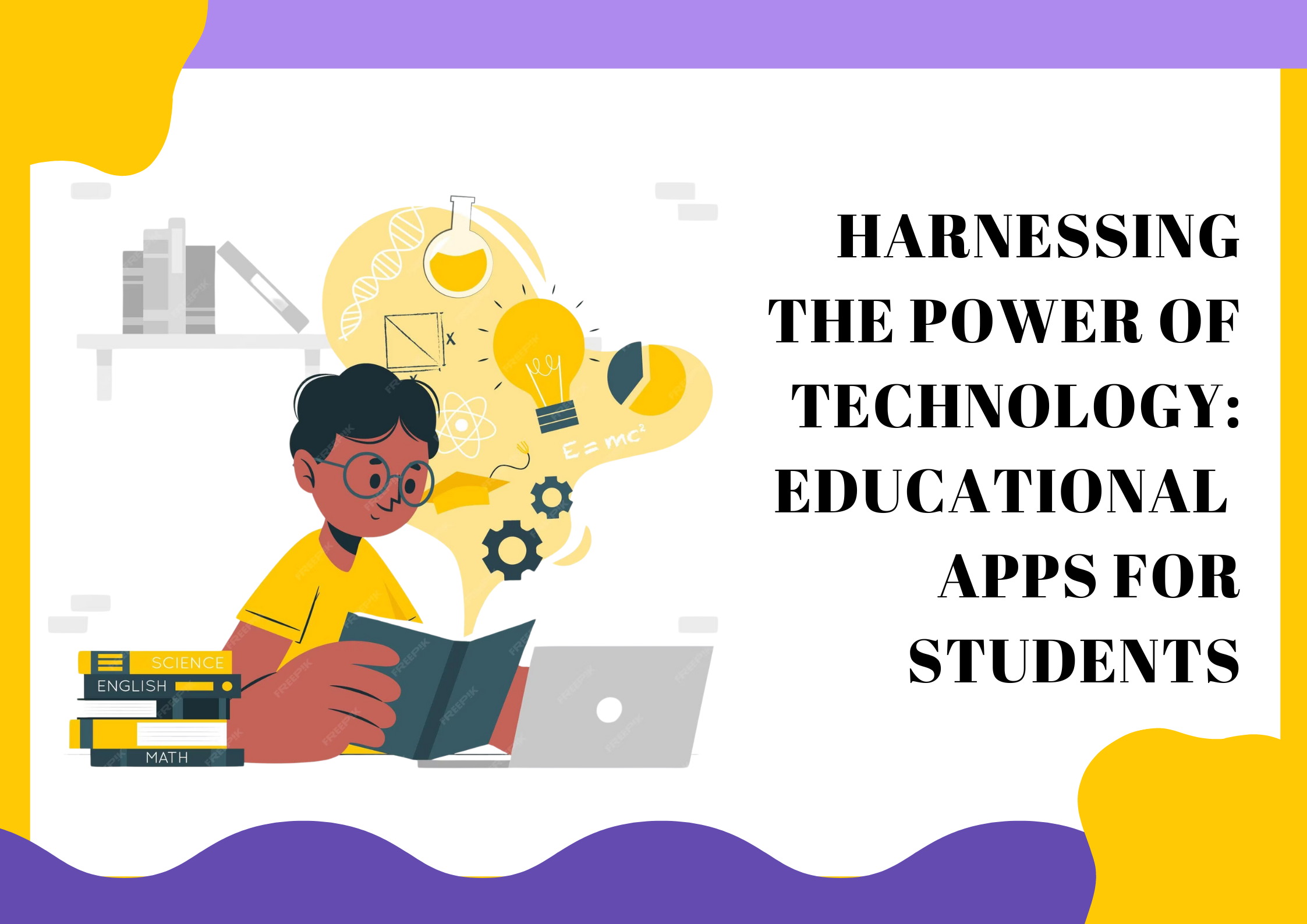In the contemporary landscape of education, the integration of technology has become a paramount force in shaping the learning experiences of students.
Educational apps for students, designed to harness the power of technology, have emerged as dynamic tools that not only complement traditional teaching methods but also revolutionize the way students engage with educational content through different Educational apps for students.
This exploration will delve into the significance of educational apps for students, tracing the evolution of technology in education, elucidating the myriad benefits they offer to students, categorizing the types of educational apps for students available, examining the challenges and considerations associated with their implementation, and finally, envisioning the future trends in this ever-evolving realm.
The Evolution of Educational Technology

Historical Perspective
The integration of technology into education is not a recent phenomenon. It has evolved over the years, with roots traceable to the advent of computers in the mid-20th century.
Early educational technology focused on using audio-visual aids, projectors, and educational films. The transition to digital technology in the late 20th century paved the way for the development of computer-based educational programs.
Impact of Technological Advancements on Education
As technological advancements accelerated, so did their impact on education. The proliferation of the internet, coupled with the development of personal computers and later, mobile devices, marked a transformative period for educational technology.
The ability to access information at one’s fingertips revolutionized the learning landscape, setting the stage for the emergence of educational apps for students.
Rise of Educational Apps for Students
The past decade has witnessed an unprecedented surge in the popularity of educational apps for students . These apps leverage the ubiquity of smartphones and tablets to deliver interactive and engaging educational content.
The shift towards mobile learning has been accelerated by the inherent flexibility and accessibility offered by educational apps for students , making learning more personalized and adaptable to individual student needs.
Benefits of Educational Apps for Students
Accessibility and Flexibility
One of the primary advantages of educational apps for students is their accessibility. Students can access learning materials anytime, anywhere, breaking the constraints of traditional classroom settings. This flexibility accommodates diverse learning styles and paces, enabling students to learn at their own convenience.
Personalized Learning
Educational apps for students are designed to cater to the individual needs. Through adaptive learning algorithms, these apps can assess a student’s strengths and weaknesses, tailoring content to address specific learning gaps. This personalized approach enhances the efficacy of learning, fostering a deeper understanding of concepts.
Engagement and Motivation
Interactive features, gamification elements, and multimedia content embedded in educational apps for students contribute to increased engagement and motivation amoung them. The gamified aspects make learning enjoyable, turning education into a dynamic and interactive experience rather than a passive one.
Real-time Feedback
Educational apps for students provide real-time feedback, a feature often lacking in traditional learning environments. Immediate feedback allows students to identify and rectify mistakes promptly, reinforcing the learning process. This instantaneous response mechanism contributes to a more effective learning curve.
Types of Educational Apps for students

Subject-Specific Educational Apps for students
Educational apps for students cover a broad spectrum of subjects, catering to the diverse academic needs of students. Subject-specific apps, such as those focusing on mathematics, science, and language arts, provide targeted content to enhance understanding and proficiency in specific disciplines.
Skill Development Apps
In addition to academic subjects, there is a growing emphasis on skill development through educational apps for students. These apps focus on cultivating critical thinking, problem-solving, and creativity, preparing students for the demands of the 21st-century workforce.
Exam Preparation Apps
Exam preparation is a crucial aspect of education, and educational apps have filled this niche admirably. These apps offer test-taking strategies, practice tests, and performance analytics, providing students with a comprehensive toolkit to excel in examinations.
Challenges and Considerations
Accessibility Issues
While educational apps offer enhanced accessibility, there are concerns regarding equitable access to technology. Disparities in access to smartphones, tablets, or a stable internet connection can exacerbate educational inequalities.
Privacy and Security Concerns
The integration of technology in education brings forth concerns related to the privacy and security of student data. Educational apps often collect substantial amounts of data, necessitating robust measures to safeguard sensitive information.
Technological Disparities
Not all educational institutions or students have equal access to cutting-edge technology. Bridging the technological divide requires concerted efforts to ensure that all students can benefit from the advantages offered by educational apps.
Balancing Screen Time
As educational apps become integral to the learning process, there is a need to strike a balance between digital and non-digital learning experiences. Excessive screen time can have adverse effects on students’ health and well-being, necessitating a thoughtful approach to technology integration.
Successful Case Studies
Examples of Educational Apps Making a Positive Impact
Numerous educational apps have demonstrated their effectiveness in facilitating learning. For instance, language learning apps like Duolingo have made language acquisition engaging and accessible, while apps like Photomath have revolutionized math learning through real-time problem-solving.
User Testimonials and Success Stories
Real-world success stories and testimonials from students, teachers, and parents highlight the tangible benefits of educational apps. These narratives provide insights into how educational apps have positively influenced learning outcomes and student engagement.
Future Trends in Educational Apps

Integration of Artificial Intelligence
The future of educational apps lies in the integration of artificial intelligence (AI). AI algorithms can further personalize learning experiences by adapting content based on individual learning styles, preferences, and performance.
Gamification in Education
Gamification is expected to play a more significant role in educational apps, making learning more enjoyable and immersive. By incorporating game elements such as rewards, challenges, and competitions, educational apps can motivate students to actively participate in their learning journey.
Augmented and Virtual Reality in Learning
The advent of augmented reality (AR) and virtual reality (VR) technologies is poised to transform educational apps into immersive learning experiences. These technologies can create virtual environments that simulate real-world scenarios, enhancing the understanding of complex concepts.
Recommendations for Effective Implementation
Collaboration between Educators and App Developers
A collaborative approach between educators and app developers is crucial for the effective integration of educational apps into the curriculum. Educators can provide insights into pedagogical requirements, ensuring that apps align with educational objectives.
Continuous Monitoring and Evaluation
Continuous monitoring and evaluation of the effectiveness of educational apps are essential. Regular assessments help identify areas for improvement, ensuring that the apps remain aligned with evolving educational standards and methodologies.
Professional Development for Teachers
Teachers play a pivotal role in implementing educational apps successfully. Providing professional development opportunities for teachers ensures they are proficient in leveraging technology to enhance the learning experience and support students effectively.
Conclusion
In conclusion, the harnessing of technology through educational apps represents a transformative force in the realm of education. From the evolution of educational technology to the diverse benefits offered by educational apps, this exploration has shed light on the pivotal role technology plays in shaping modern education.
While challenges exist, the success stories, future trends, and recommendations for effective implementation emphasize the immense potential for educational apps to revolutionize the learning landscape.
As we navigate the digital frontier, the collaboration between educators, app developers, and stakeholders becomes paramount in ensuring that the power of technology is harnessed responsibly for the betterment of education.













